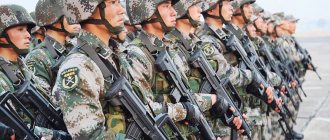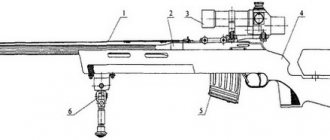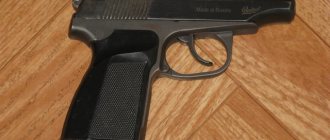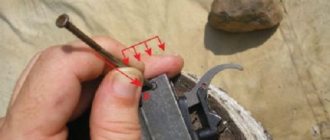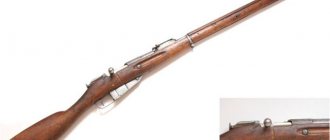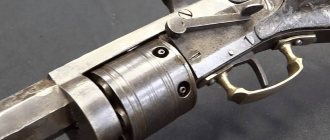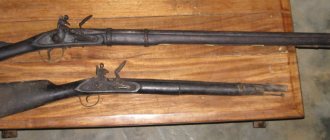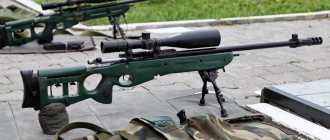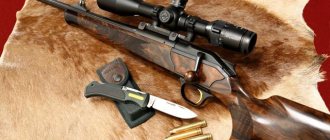Based on the three-line rifle designed by Sergei Mosin, three types of carbines were created in the Russian Empire and the USSR and adopted by the Army. All these models were created and put into service after Mosin’s death.
They retained the design, magazine capacity and appearance of the rifle, but differed in length, sights and bayonet (in relation to the carbine model 1944). At the same time, by the end of the Great Patriotic War, from a weapon of special forces, the carbine began to turn into a mass weapon of the most diverse branches of the USSR military.
The first carbine of the 1907 model
The first serial carbine created on the basis of a three-line rifle was the 1907 model carbine, developed by N. Yurlov. In the army, the carbine was supposed to arm artillerymen, horse patrols, and infantry units. The carbine itself was significantly shorter than the rifle and had a sight for shooting at a distance of up to 2000 steps. Despite the official adoption of the model in May 1907, mass production of the carbine began much later - only in 1909.
Model 1907 carbine. (sitekid.ru)
The Izhevsk plant received the order to produce the carbine. True, the share of carbines in relation to the production of rifles was small, and the planned plan for 1909 for the production of carbines could not be fulfilled. Thus, according to the Most Submissive Report to the War Ministry on the activities and state of all branches of military administration for 1909, it was indicated that the Izhevsk Arms Plant planned to produce 21,157 3-lin. carbines. But before December 1, 1909, only 8,496 units were manufactured.
The situation with the production of carbines continued to remain difficult in subsequent years. So in the report for 1911 Fr. In total, before the start of the First World War, more than 118 thousand carbines were produced - not so much, considering that the production of, for example, infantry rifles before 1914 exceeded 3.3 million units.
This weapon did not become widespread: after the First World War, the carbine quickly disappeared from the army. At the moment, carbines of the 1907 model are museum rarities. Thus, the Central Museum of the Armed Forces in Moscow exhibits a carbine that was presented to Sergei Kamenev, one of the two commanders-in-chief of the armed forces of the Republic during the Civil War.
Modifications
Mosin's "Three Line" was adopted, the technical characteristics of which differed in 3 modifications, for different branches of the military. Basically, barrel length:
- option for infantry. Long bayonet and barrel;
- the cavalry variation had a shortened barrel and a different principle for fastening the belt;
- the Cossack version was not equipped with a bayonet and had the shortest barrel length.
The bayonet that was supplied with the rifle had a tetrahedral shape, was attached using a pipe-shaped coupling, and the tip had a horizontal sharpening. This design feature was considered obsolete.
An interesting fact about this bayonet was that it was used as a screwdriver when disassembling a gun. For this purpose, a tip of this shape was provided.
Bayonet from a Mosin rifle
During combat operation, another unpleasant fact was revealed. The bayonet could not be removed, and the weapon was always carried in a combat position. When the gun was unlocked, the balance and shooting accuracy were disrupted. The deficiency was corrected during modernization, already in 1930.
Model 1938 carbine
Despite the fact that the 1907 model carbine did not take root in either the Tsarist or the Red Army, the very idea of creating a shortened model based on the “three-line” remained. Such weapons, contrary to popular belief, were intended not for cavalry, but for units where small arms played an auxiliary role - artillerymen, engineering units, signal troops. This is how the 1938 model carbine appeared.
It is often said that this model was a further development of the 1907 carbine, but this is not so. The 1938 model carbine was created on the basis of the 1891/1930 model Soviet rifle. The first carbines were distinguished by sighting devices (the absence of a target) and a unique stock. But in this situation, the production of a carbine was very expensive (250 rubles for the production of a carbine and 166 rubles for a rifle).
Model 1938 carbine. (wwii.space)
As a result of 1940, there was a certain unification in the production of rifles and carbines, which made it possible to reduce the cost of producing carbines. In the first half of 1941, the Izhevsk plant produced approximately equal numbers of rifles and carbines, but with the beginning of the Great Patriotic War, the share of rifles in production increased sharply again, in order to make up for the huge losses of “three-line rifles” at the front.
Despite the adoption of the 1944 model carbine with a folding bayonet, production of the 1938 model carbine continued in small batches until the end of 1945. Among the heroes of the Great Patriotic War, whose weapon was the model carbine. 1938, you can remember Alexander Matrosov - he is always depicted with a sist submachine gun. Shpagin, and there is even a PPSh that belonged to Matrosov (or that, due to circumstances, ended up in his hands in battle), but on Matrosov’s military ID it is a carbine of the 1938 model that is listed as a personal weapon.
Mosin rifle aka three-ruler photo
Mosin rifle aka three-ruler photo.
At the end of the 80s of the 19th century, all armies of Europe were re-equipped with repeating rifles. For firing from them, unitary cartridges with smokeless powder and a jacketed bullet were used.
This is interesting: Our famous chemist Dmitry Ivanovich Mendeleev also participated in the creation of smokeless domestic gunpowder. And the Russian army was armed with a Berdan rifle, the rifle was single-shot. Designer Hiram Berdan. The Berdan rifle lagged behind store-bought rifles in all respects.
In 1889, a competition was announced to create a repeating rifle chambered for a three-line cartridge. One of the participants was Tula gunsmith Captain Sergei Ivanovich Mosin.
SERGEY IVANOVICH MOSIN
Whose sample of the rifle with various modifications won the competition. On April 16, 1891, Emperor Alexander III, by his decree, approved the model of the rifle, crossing out the word “Russian”; accordingly, the rifle was finally adopted for service under the name “ three-line rifle of the 1891 model .” Why is the word three-linear in the title? In those days, our designers used the English measurement system; the caliber of small arms was displayed in lines. One line equals 1/10, one tenth of an inch, or 2.54 mm, and three lines equal 2.54 mm x 3 = 7.62 mm in the metric system.
three lines correspond to 7.62 mm
This is where the familiar and popular name “ three-line rifle ” comes from, also known as the Mosin rifle photo. Contrary to established tradition, the authorities deprived the rifle of the name of its creator.
three-ruler Mosin, photo in the Gelendzhik museum, the difference in length is visible between the dragoon version with which our army met the Great Patriotic War and the cavalry, shorter
The rifle barrel is rifled (4 rifling, curling from left to top to right). The caliber of the barrel, measured as the distance between the opposite fields of the rifling, is nominally equal to 7.62 mm, or 3 Russian lines (in reality, as shown by measurements carried out on a large number of rifles of different years of production and varying degrees of preservation, it is 7.62...7.66 mm). The rifling caliber is 7.94…7.96 mm. The diameter of the bullets is 7.85...7.89 mm.
clip of cartridges from a three-line Mosin rifle photo
At the rear of the barrel is a smooth-walled chamber designed to accommodate the cartridge when fired. It is connected to the rifled part of the barrel using a bullet entrance. Above the chamber there is a factory mark that allows you to identify the manufacturer and year of manufacture of the rifle.
factory mark allowing to identify the manufacturer and year of manufacture of the rifle
At the rear, a receiver is tightly screwed onto the threaded stump of the barrel, which serves to house the bolt. A magazine box with a feed mechanism was attached to it, in turn, five rounds were loaded into the magazine, a cut-off reflector and a trigger mechanism.
three-ruler drawing diagram
Initially, a rifle cartridge of the 1891 model was used for the rifle; the cartridge bullet had an oval shape.
cartridge sample 1891 g cartridge bullet had an oval shape
By the end of the Russo-Japanese War, this cartridge was considered obsolete. At that time, the armies of Europe were already using a cartridge with a pointed bullet. The advantage of a pointed bullet is that it is lighter, has a higher initial speed, and better streamlining.
New cartridge of the 1908 model
The new cartridge was put into service in 1908. With the introduction of a new cartridge, the Mosin rifle, also known as the three-line rifle, photo was changed. The rifle's sight has changed, and the rifle also received a barrel guard. It was in this form that she met the First World War. The rifles were produced in dragoon, infantry and Cossack varieties. At the beginning of the First World War, the Russian army also had only three types of small arms. The main weapon of the infantry was the Mosin rifle, also known as the three-line rifle , the officer ranks were entitled to a revolver, and the Maxim heavy machine gun served as a means of fire support. All three weapons had the same cartridge caliber.
Mosin rifle options photo
Although by that time in some countries, primarily in Germany, which had a very highly developed production base, cartridges with an annular groove on the sleeve had already been introduced, more compact and convenient for feeding from the magazine, the Russian cartridge retained a protruding rim, mainly due to the fact that , that this made it possible to produce both the sleeve and the barrel chamber with large tolerances. Other advantages of a cartridge with a rim were also noted - for example, it was more convenient when equipping a magazine or loading a rifle one cartridge at a time, which was a very real possibility if the magazine failed or there were no loaded cartridge clips, since it was easier and faster for a soldier to pull out of the cartridge bag . At that time, this did not represent anything unusual - for example, such cartridges as the French 8×50 mm R Lebel (English), the English .303 British (7.7×56 mm R), and the American .30-40 Krag (English) (7.62×58.8 mm R), or the same Austro-Hungarian M1888 (8×50 mm R Mannlicher). Only later did the great inconvenience of such a cartridge for use in automatic weapons become apparent, but this did not prevent some of the above-mentioned samples from remaining in service until the end of World War II. Moreover, even in the 1930s, some countries continued to develop and adopt new rifle cartridges with a rim, for example, the Austrian cartridge M30S 8?56 mm R arr. 1930, also adopted in Hungary.
7.62 x 54mm cartridge options
- This is interesting: By the way, with minor changes, the Dragunov sniper rifle, the PKM single machine gun, the Pecheneg infantry machine gun, the GShG aviation four-barreled machine gun and other types of army weapons are still used for it.
- Due to a catastrophic shortage of weapons and problems of domestic industry, the Russian government ordered 1.5 million rifles mod. 1891/10 from the American companies Remington and Westinghouse. Some of the “American mosquitoes” were never delivered to Russia - after the revolution, the US government confiscated them and they were adopted as US Rifle, Cal. .30, Model of 1916. Today, American-made Mosin rifles are among the rarest and most collectible.
- In total, from 1891 to 1945, about 26,000,000 million rifles were produced. Moreover, the Mosin rifle, also known as the three-line rifle, was produced in the amount of 12,000,000 million units during the war. Thus becoming one of the most popular rifles in the world.
- During the fighting in World War II, it was the rifle that was the most common small arms in all the armies that took part in it, and not the automatic weapons presented to the masses with the help of cinema.
- If the Red Army had practically no problems with the availability of automatic weapons (except perhaps at the end of 41, when warehouses were lost), then the problem of the availability of automatic weapons in the Wehrmacht was never resolved until the end of the war. The attacking chain of German machine gunners could not exist in principle (in Russian cinema they probably don’t know about this), there was not a single unit in the German army equipped with MP 40 machine guns (a frankly crap weapon), you can comb the entire Internet, but you still won’t find a photo on in which more than three soldiers armed with a machine gun were filmed at the same time, even if one of them is a platoon commander, and the other two are squad commanders. In our guards regiment staff there were two companies of machine gunners armed with PPSh-41.
Pay attention to all the Mauser 98k rifles.
A German infantry unit is fighting on the outskirts of the village, all with carbines and so on from photo to photo
In 1922, instead of three options for the Mosin rifle, also known as the three-line rifle , it was decided to leave only one option - the dragoon rifle with a bayonet. In 1930, the three-line rifle was modernized and became a single model for all branches of the Red Army. The bayonet began to be attached differently, the remaining changes were mainly related to manufacturability. The name of the designer appeared in the name of the rifle. The three-line rifle was named the Mosin system rifle of the 1891-30 model. In such a changed form, it met the Second World War and the Great Patriotic War.
At the same time, in the Manual of 1938 and its reprint of 1941, and in the brochure for OSOAVIAKHIM in 1941 “The Rifle and Its Use,” and in the Manual of 1954, the rifle (in the version after the modernization of 1930) is simply called “mod. 1891/30”, without any mention of any surnames, despite the fact that the designations of other models (self-loading rifle and carbine of Tokarev, submachine guns of Shpagin and Sudaev, and others) in similar literature were almost always supplied with notes like “designs of such something" or "system of such and such." Thus, it is likely that even during this period, the “impersonal” name according to the year of its adoption into service continued to be used officially in relation to the rifle.
The Mosin rifle, also known as the three-line rifle , was the most popular in both the Russian and Red Army, they fought with it both for the Tsar and for Soviet power, went on the attack for the Motherland and for Stalin, the Mosin rifle, also known as the three-line rifle, was produced almost until the end of the war, this rifle together with the soldiers of the Red Army reached Berlin. The Mosin rifle, also known as a three-line rifle, and no other weapon was the main weapon of the Red Army in the Great Patriotic War. Submachine guns and machine guns were far from matching the number of Mosin rifles produced.
But its displacement during the Great Patriotic War by more modern models of small arms was predetermined. As can be seen from war photographs of that time. Using them you can clearly trace the dynamics.
This is interesting: Photographs by photographers of the Great Patriotic War were used. 1941
All as one with the Mosin rifle, also known as a three-ruler rifle.
Red Square November 1941
It is unclear why they shoot without bayonets.
from a three-line series on 1941 aircraft, the photo is most likely staged
All have three-line rifles, as it should be with fixed bayonets.
Counterattack of Soviet troops, Donetsk region, October 1941
1942 Automatic weapons begin to flash.
Chain of attacking soldiers, July 1942
Again without automatic weapons.
Red cavalry 1942, not a very indicative photo, the cavalry unit was a priori armed with a carbine, but by the end of the war machine guns appeared in the cavalry units
1944 Automatic weapons are more and more common.
On the approaches to Mogilev 1944
On the streets of Budapest
Red Army on the streets of Budapest
Victorious 1945. The rifle in the photo is becoming increasingly rare.
Fights. Austria
The Russians have arrived, most likely in the photo there is a company of machine gunners
Notice that almost all of them have machine guns, and not a single rifle. And the same picture from photo to photo.
Berlin (May 2, 1945) Raising of the Victory Banner
Victory salute from all guns, you still have to try to find the rifle...
Victory salute from all guns
The use of rifles by snipers In the thirties, the “Voroshilov shooters” movement was popular in the USSR. This certainly helped sniper training (however, sniper tactics and the use of an optical sight were not taught). During the Great Patriotic War, a large number of snipers were urgently trained. They shot mainly from a three-line Mosin rifle. The USSR also had other sniper rifles, for example the SVT-40 with an optical sight, but in terms of combat qualities and, most importantly, accuracy of fire, they could not compare with the proven “three-line”. Controversial statement
In 1932, mass production of the sniper rifle mod. 1891/31 (GAU index - 56-B-222A), distinguished by improved quality of processing of the barrel bore, the presence of an optical sight PE, PB or PU and a bolt handle bent down. A total of 108,345 units were produced. sniper rifles, they were intensively used during the Soviet-Finnish and World War II and proved to be a reliable and effective weapon.
personalized Mosin sniper rifle A.G. Zhirnokleev
Currently, Mosin sniper rifles are rare and highly valued by collectors (especially the “registered” rifles, which were awarded to the best Soviet snipers during the Great Patriotic War). Already in our time, on the basis of the outdated Mosin sniper rifle, the compact OTs-48K sniper rifle, rearranged according to the “bullpup” scheme, was developed and produced in small series, which is in service with a number of units of the Ministry of Internal Affairs.
- This is interesting: on average, 18,000 - 25,000 bullets were spent per killed enemy soldier in World War II. For snipers, this figure is 1.3-1.8 bullets.
The debate still continues to this day about which of the rifles from the countries that participated in World War II is the best; we should not forget that wars are won by people armed with certain types of weapons. The results of World War II are known. Our legendary Mosin rifle, also known as the three-line photo , was in service with the Red Army, one of the winners of World War II. But the no less legendary German rifle, also known as the Mauser 98k repeating carbine, which was in service with the German armies, lost both world wars in succession. Fact .
Mauser 98k repeating rifle
This is an interesting conclusion: The Mosin rifle, also known as the three-ruler photo , has both advantages and disadvantages.
Advantages.
- Good ballistics and high power of the cartridge (at the level of .30-06), despite the fact that many analogues at that time still used black powder;
- Greater survivability of the barrel and bolt;
- Undemanding manufacturing technology and large tolerances;
- Reliability, trouble-free operation of rifle mechanisms in any conditions;
- Simple and reliable design of the shutter, consisting of only 7 parts; it disassembles and assembles quickly and without any tools;
- The magazine box is well closed at the bottom;
- Durable stock and butt;
- Cheap frame clip;
- Easily removable shutter for cleaning;
- Sufficient rate of fire of the rifle;
- A separate combat bolt cylinder, replacing which if broken is much cheaper than replacing the entire bolt;
- Cheapness of replacing wooden parts;
Flaws.
- An outdated cartridge with a rim that made it difficult to feed from the magazine and required the introduction of an otherwise redundant part, quite complex to manufacture and vulnerable to damage - a cut-off reflector (later, during modernization, replaced by two parts that were easier to manufacture; however, the most advanced magazine systems ensured reliable supply of cartridges with a rim and without a cut-off as a separate part, for example, the Lee system magazine for the Lee-Metford and Lee-Enfield rifles, which was also double-row, due to which, in the same dimensions, it accommodated not 5, and 8-10 rounds, depending on the caliber);
- Horizontal arrangement of the bolt cylinder lugs when locking, increasing dispersion; rifles with the best fighting already at that time had a vertical arrangement of the lugs with the bolt locked;
- A long and difficult descent without “warning”, interfering with accurate shooting;
- Frame non-spring clip, making loading difficult; The spring plate clips that already existed at that time, including the Mosin clip, were more advanced, although more expensive than the accepted Nagan clip;
- A long and extremely outdated needle bayonet with a cranked neck, mounted on the barrel and not on the stock - however, according to some opinions, more effective directly in bayonet combat than short bladed bayonets of rifles from other countries;
- Infantry and dragoon rifles were sighted with a bayonet, that is, when shooting, it had to be on the rifle, otherwise the point of impact shifted significantly, which made the weapon ready for battle cumbersome; the bayonet became loose over time, as a result of which the accuracy of shooting from the rifle decreased; the Cossack rifle could be sighted without a bayonet, but was still too heavy and generally inconvenient for shooting from a horse and being carried by a cavalryman; The loosening of the bayonet has been eliminated in the mod. 1891/30, but the bayonet still had to be on the weapon when firing; This problem was completely solved only on the carbine mod. 1944 with the introduction of an integral switch bayonet, which also remained on the weapon when firing, but could be folded, increasing the ease of handling;
- A short bolt handle that is not bent downwards, making it difficult to open it, especially when the cartridge case is tightly “slung” in the chamber; the handle is strongly moved forward due to the design of the bolt and its horizontal position without bending down, which forced the shooter to remove the butt from the shoulder when reloading, thereby reducing the rate of fire; (with the exception of sniper modifications, which had a longer handle bent down); advanced models of those years already had a handle that was set far back, bent downwards, which made it possible to reload the weapon without removing the butt from the shoulder, thereby increasing the rate of fire - the handle of the Lee-Metford rifle can be considered a reference in this regard;
- It is curious that both the experimental Mosin rifle of 1885 and the Nagan rifle had a bolt handle moved back, located in a special cutout, separated from the window for ejecting spent cartridges by a jumper, which also strengthened the receiver; however, even during testing of the 1885 rifle, it became clear that with this position of the handle, delays often occur during reloading, caused by the fact that the long sleeves of the soldier's overcoat fell between the bolt stem and the receiver;
- Straight neck of the butt, less convenient when shooting than the semi-pistol version on the latest models of rifles at that time, although more durable and convenient in bayonet combat;
- The Mosin fuse is very simple, but inconvenient to use and short-lived;
- Some lag behind advanced foreign analogues in the design of small parts and accessories, for example - outdated and quickly loosening stock rings, a sight vulnerable to impacts, less convenient than the side, lower "infantry" swivels (since 1910, replaced by also not the most convenient slots for belt passages, originally available on the dragoon rifle), inconvenient ramrod stop, and so on;
- Low quality of wooden parts due to the use of cheap wood, especially on later releases..
Rating: Mosin rifle, also known as a three-line rifle, photo.
- In general and in general, assessing the rifle from the perspective of its time and in relation to the specific conditions of the production and operation of military weapons in the Russian Empire, we can say that, although it does not represent a revolutionary new or unique weapon in its characteristics, in terms of the overall set of properties and qualities was sufficiently close to the best model that could be adopted in those years.
- Having a number of objective shortcomings from the point of view of design and operation, nevertheless, it was quite capable of successfully fulfilling its main purpose, replacing in the troops the single-shot Berdan rifle chambered for black powder.
- Its main combat qualities - bullet ballistics, combat accuracy, rate of fire, operational reliability - fully met the requirements of that time for this class of weapons, and at the same time, in terms of its design and technological features, it was adapted for production primarily by the domestic Russian industry in quantities sufficient for full armament of the Russian army, the most numerous in Europe at that time, as well as for exploitation by soldiers who often did not have the proper level of technical or simply general literacy.
- The adoption of a more advanced, but also more complex in design and production model at that time could well have led to the fact that the Russian army would have approached the First World War, still predominantly armed with outdated Berdan rifles, given that even the deployment of production of a relatively high-tech “Mosinki” in domestic factories faced very great difficulties, and attempts to order weapons abroad, especially in wartime, had only partial success and in no way could provide them in sufficient quantities to arm the entire army.
Specific shortcomings of the system, which were relevant at the time of adoption of the weapon, in conditions when the repeating rifle played a leading role in the infantry weapon system, and were decisive in comparison with its Western counterparts, by the 1920s had basically lost any significant significance in view of the displacement of rifles from many niches by other types of weapons, mainly by machine guns, after the mass introduction of which in armies the task of firing rifles at long ranges practically disappeared. By the period of the Second World War, the combat qualities of repeating rifles were largely leveled out, regardless of the specific advantages and disadvantages inherent in individual systems, since the latter no longer played a significant role in terms of the effectiveness of the use of weapons in real combat conditions - various magazine systems rifles turned out to be equally outdated against the background of more advanced automatic weapons and continued to be produced only due to their low cost, achieved by a high degree of refinement of production technology. In such conditions, the simpler and more technologically advanced “Mosinka” even received a certain advantage over, say, the significantly more complex and expensive Lee-Enfield and Mauser rifles, since it could be produced faster and cheaper than them, and to the requirements that were put forward for At this stage, this type of weapon was fully consistent.
Model 1944 carbine
One of the weak points of the “three-line” was the long needle bayonet, which often caused a lot of trouble for the owner during the campaign and in battle. It was inconvenient to keep it constantly attached. The bayonet fight itself was quite a rarity in the 20th century. And the loss of bayonets, which were broken, lost or lost under other circumstances, was very significant. Thus, in 1943, in the troops of the North Caucasus Front, the percentage of bayonet losses was 71.6%, the Western Front - 69%, and the Northwestern Front - 63%. And in 1944, in parts of the 1st Baltic Front, the number of bayonets was at the level of 10-13%.
At the same time, abandoning the bayonet altogether and focusing on the production of carbines of the 1938 model was not easy from the point of view of traditions and the prevailing idea of what an infantry weapon should look like. The bayonet, losing its direct meaning on the battlefield, continued to remain one of the attributes and symbols (and this is not only in the USSR) that is difficult to abandon. And a solution was found in creating a model that would be compact, like a carbine, and at the same time allow the use of a folding needle bayonet. And the 1944 model carbine became such a weapon.
Model 1944 carbines in a pyramid. (cont.ws)
Unlike its predecessor, the carbine mod. 1944 was equipped with a relatively short folding bayonet of the Semin system. It was no longer created as an additional model, but as a mass-produced weapon of a wide variety of military branches. The production of the new carbine began in May 1944. At the same time, there is a gradual curtailment of the production of the 1891/1930 model rifle and, conversely, an increase in the production of the carbine with a bayonet.
The main production of the 1944 model carbine was carried out in Izhevsk from 1944 to 1949, until it was replaced in production by the SKS-45. In the 1950s, as production of new models increased, carbines of the 1944 model were gradually transferred to warehouses. True, some of the carbines, along with the “three-line” ones, were supplied from the USSR, and the armies of other states - these weapons were in service with a number of Warsaw Pact countries for some time, were used during the Korean War, and these days are very rare, but are still found in hotbeds of local conflicts.
Rifle characteristics
The rifle developed by Mosin became popular not only in the Soviet Army. The characteristics of the weapon also pleased hunters who still use this weapon when hunting. Let's look at the characteristics of a standard rifle that does not have an optical sight:
- number of shots - 5
- barrel caliber - 7.62 mm
- combat rate of fire - 14 rounds per minute
- maximum rate of fire - 55 rounds per minute
- sighting range - 2000 meters
- maximum firing range - 3500 meters
- effective firing range - 600-800 meters
- weight with bayonet - 4.5 kg
The dimensions of the weapon are not much different from their “brothers”. So, the length together with the bayonet is 166 cm, respectively, the length of the rifle without the bayonet is 114 cm. The bayonet-knife itself is flat in shape, it is also used as a screwdriver.
A little about the places of production
The industry of the Russian Empire at the time of 1891 did not make it possible to establish full-fledged production of the “three-line”. Therefore, the first batches of new weapons were ordered from the French Chatellerault.
Later, in 1894, the production of “mosinki” began at domestic arms factories. First at the Sestroretsk arms factory near St. Petersburg (it was led by Mosin himself), and then in Tula and Izhevsk.
Mosin sniper rifle
During the First World War, Russian industry could not cover the needs of the army. The rifles were ordered from the USA and delivered by sea.
After 1917, a large number of guns that were never sent to Russia remained in warehouses in the United States. Later they were used to train recruits or sold to other countries.

